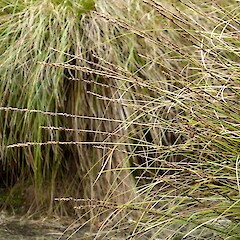Carex virgata
Common name
swamp sedge, pukio, toitoi, toetoe
Synonyms
Carex paniculata var. virgata (Boott) Cheeseman; Carex appressa var. virgata (Boott) Kük.
Family
Cyperaceae
Flora category
Vascular – Native
Endemic taxon
Yes
Endemic genus
No
Endemic family
No
Structural class
Sedges
NVS code
The National Vegetation Survey (NVS) Databank is a physical archive and electronic databank containing records of over 94,000 vegetation survey plots - including data from over 19,000 permanent plots. NVS maintains a standard set of species code abbreviations that correspond to standard scientific plant names from the Ngä Tipu o Aotearoa - New Zealand Plants database.
CARVIR
Current conservation status
The conservation status of all known New Zealand vascular plant taxa at the rank of species and below were reassessed in 2017 using the New Zealand Threat Classification System (NZTCS) – more information about this can be found on the NZTCS website. This report includes a statistical summary and brief notes on changes since 2012 and replaces all previous NZTCS lists for vascular plants.
Please note, threat classifications are often suggested by authors when publications fall between NZTCS assessment periods – an interim threat classification status has not been assessed by the NZTCS panel.
- Conservation status of New Zealand indigenous vascular plants, 2017 . 2018. Peter J. de Lange, Jeremy R. Rolfe, John W. Barkla, Shannel P. Courtney, Paul D. Champion, Leon R. Perrie, Sarah M. Beadel, Kerry A. Ford, Ilse Breitwieser, Ines Schönberger, Rowan Hindmarsh-Walls, Peter B. Heenan and Kate Ladley. Department of Conservation. Source: NZTCS and licensed by DOC for reuse under the Creative Commons Attribution 4.0 International licence.
2017 | Not Threatened
Previous conservation statuses
2012 | Not Threatened
2009 | Not Threatened
2004 | Not Threatened
Distribution
Indigenous. New Zealand: North, South, Stewart and Chatham Islands.
Habitat
Widespread from sea level to about 1000 m a.s.l. in open, swampy conditions and also in damp sites within lowland forest. In parts of the country this sedge is often the dominant carice of lowland alluvial forest.
Wetland plant indicator status rating
Information derived from the revised national wetland plant list prepared to assist councils in delineating and monitoring wetlands (Clarkson et al., 2021 Manaaki Whenua – Landcare Research Contract Report LC3975 for Hawke’s Bay Regional Council). The national plant list categorises plants by the extent to which they are found in wetlands and not ‘drylands’. The indicator status ratings are OBL (obligate wetland), FACW (facultative wetland), FAC (facultative), FACU (facultative upland), and UPL (obligate upland). If you have suggestions for the Wetland Indicator Status Rating, please contact: [Enable JavaScript to view protected content]
FACW: Facultative Wetland
Usually is a hydrophyte but occasionally found in uplands (non-wetlands).
Detailed description
Rhizomatous, densely clumped to tussock-forming sedge. Rhizome 5 mm. diameter. Culms 150–900 mm. × c. 1.5 mm, trigonous, grooved, harshly scabrid; basal sheaths shining, grey-brown to dark brown, sometimes black. Leaves much > culms, 0.5–1.2 m tall, 1.5–4.5 mm wide, channelled, light green, harsh and rigid, keel and margins strongly scabrid. Inflorescence a narrow 100–260 mm long panicle with stiff erect branchlets, the lower-most quite distant. Spikes androgynous, 4–6 mm. long, sessile, grey- or yellow-brown, male flowers terminal, lower spikes on each branchlet subtended by a pale membranous bract with a long scabrid awn often > spike. Glume ± = or slightly < utricles, membranous, ovate, acute, dull brown, with a prominent pale midrib, this often scabrid in lowermost glumes. Utricles 2.0–2.5 × c. 1.0 mm, plano-convex, ovoid, light grey with distinct brown nerves; tapering to a brown beak c. 0.5 mm long with a bifid orifice and conspicuously denticulate margins; abruptly contracted to a narrow stipe c. 0.2 mm. long. Stigmas 2. Nut slightly > 1 mm. long, biconvex, ovoid, dark brown.
Similar taxa
Carex virgata most closely resembles C. appressa R.Br., especially as the inflorescence of both species is a stiff contracted panicle, further, both species have similar distinctly nerved utricles. However, C. virgata has more slender culms, narrower leaves and paler brown, less dense-flowered panicles. Plants of C. virgata could also be confused with C. secta Boott as they can occasionally become elevated on trunks formed by matted rhizomes and semi-decayed culms. However, in such rare examples of C. virgata, plants never attain the height reached by C. secta. Further, the inflorescences of C. virgata are never drooping, and obviously branched, with the basal branchlets often distant.
Flowering
October–December
Fruiting
December–May
Life cycle
Nuts surrounded by inflated utricles are dispersed by granivory and wind (Thorsen et al., 2009).
Propagation technique
Easily grown from fresh seed and by the division of established plants. A fast growing sedge often popular in wetland restoration and riparian plantings.
Etymology
carex: Latin name for a species of sedge, now applied to the whole group.
virgata: Twiggy
Notes on taxonomy
On the Chatham Islands C. virgata either hybridises, or appears to intergrade, with C. appressa.
Attribution
Fact Sheet prepared by P.J. de Lange (10 August 2006). Description adapted from Moore and Edgar (1970)
References and further reading
Moore LB, Edgar E. 1970. Flora of New Zealand, Volume II. Indigenous Tracheophyta: Monocotyledones except Gramineae. Government Printer, Wellington, NZ. 354 p.
Thorsen MJ, Dickinson KJM, Seddon PJ. 2009. Seed dispersal systems in the New Zealand flora. Perspectives in Plant Ecology, Evolution and Systematics 11: 285–309.
NZPCN Fact Sheet citation
Please cite as: de Lange, P.J. (Year at time of access): Carex virgata Fact Sheet (content continuously updated). New Zealand Plant Conservation Network. https://www.nzpcn.org.nz/flora/species/carex-virgata/ (Date website was queried)











